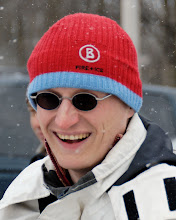Sunday, May 18, 2008
The D3 arrived. Part III: Software, DXO sucks
Before I bought my Nikon D200 I was using ACDSee and Paint Shop Pro for corrections from pictures taken with my point-and-shoot pocket cameras. However I used both pretty rarely only. So when I bought the D200 I asked several of my friends what software to use to do RAW to JPEG conversion. Many of them suggested I have a look at DXO. And in fact DXO is awesome in theory and also—if you can get it to work and happen to own the correct lenses—in practice. Unfortunately it is kind of impossible to use the software. Its user interface is the worst piece of crap I have ever seen until then. I hoped the update to the newest version would make it any better. But guess what, it became even more unstable and useless. Well the results, if you get any, are still awesome, yet kind of impossible to get. Especially with the Nikon D3. It detects the camera and lens and still refuses to do anything with the images. And before you wonder, there is no way whatsoever to make DXO work on Windows 64. They think that they produced such a holy grail of software that copy protection goes over everything. And people like them wonder why their software gets cracked... Enough anyway, DXO is gone.
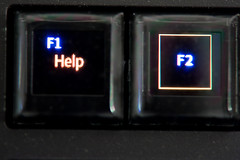
So I decided on trying the demo software that Nikon ships with the D3. Demo? Yes, that's right. You just got a damn expensive camera and Nikon didn't even bother to give you a piece of software that allows you to make use of the camera's RAW format. But, well, that is no loss because Nikon managed to produce a piece of crap that is impossible to use. Right, Nikon Capture NX comes with a user interface that is indeed worse than DXO—and I thought that would be impossible.
So I tried ACDSee pro and after the update that makes it able to handle newer RAW formats, the batch processor works fast and produces nice color and exposure corrections. Unfortunately, you won't get the nice lens/camera combination fix-up that DXO would provide. All in all, ACDSee is a very nice and fast organizing and viewing software that also allows a wide variety of corrections. And the user interface is pretty nice as well. Well done. Even after about ten years of using ACDSee I still use it. And today I actually use it more than ever before. One thing I use this for is red-eye corrections. The others are the mentioned batch converter and I also like the crop feature. Last but not least, I have always used it for image rotation, a thing ACDSee used to be famous for.
Next step, there must be something that allows for more corrections. So I tried Adobe Lightroom 2.0 beta. And again a nice very easy to use user interface. It also supports importing much more to my likings. So when you connect the camera you get an import dialog that allows to import by date shot. Something I really like: organizing by set. And if there are more sets on a day, then you simply select by picture and import into different folders. The next thing is the browser which is as fast as the one from ACDSee just not so powerful. I chose the importer of Lightroom, which automatically applies some EXIF tagging, to mark all my picture as my pictures—yes, the D3 does not allow this. All I am missing here is lens detection from EXIF information and turning that into tags. For that, I have some perl/php scripts but am usually to lazy to use them. After importing the images you can apply corrections. You can copy corrections applied to one picture to other ones and it actually works. When done with corrections, the images can be converted in a batch processor while the application still works! And if you put more pictures up for conversion, Lightroom simply adds these pictures to the stack of the batch processor. And by the way, Lightroom has a nice black&white conversion.

The third software I use is Paint Shop Pro. Several years ago I started using this software to do pixel corrections or to generate small images for web sites. In the meantime the software specializes more and more as a photography solution. It too has a usable browser and a bunch of filters. I used it, for instance, to cut pictures free—as in, make the background transparent.
My current work flow is as follows. I import images from the camera using Lightroom. I do so by set into a directory. The directory name is the date in YYYYMMDD format followed by a set description. I then use Lightroom to do color and exposure corrections as well as cropping. Alternatively I use ACDSEE to do full automatic conversion to JPEG. Sometimes I do so to speed the process up. In general, I prefer to apply as few corrections as possible. That is, I try to do nice shots in RAW with automatic WB. I select pictures for upload in several ways. First, I sometimes delete already in the camera, then I delete already before conversion to JPEG. Both ACDSee and Lightroom are fast enough to allow for browsing and deletion using only RAW. When ending up with lots of pictures in a set with several being more or less the same, I use the rating support of either software for selection. Once conversion to JPEG is done, I select once more. This time, however, I only delete the JPEGs, keeping the RAW images. The last step is uploading. For this I use Flock's built-in uploader to flickr.
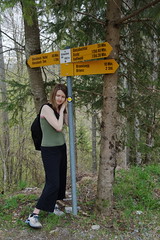
The reason for using flickr is simple. It was working for me prior to anything else by the time my D200 made me constantly run out of space on my own server. Today I would definitively use Panoramio instead. And the reason for that is simple too. It has a very nice integration with maps.google.com (check out the new 'More...' button) and they are way better than Yahoo maps.
Conclusion. ACDSee, Lightroom and PaintShopPro all have a usable user interface, especially the former two. Once Lightroom 2 gets released I will buy it, probably bundled with PhotoShop. I haven't used that in a long time. But the combination sounds like a very good idea. And hopefully it is better than having to switch to something completely different like PaintShopPro. I tried a bunch of uploader tools, but the only one that works for me is Flock.
Final note. DXO in theory is an awesome tool. But it is in fact completely useless crap, it does not work, the support is unbelievable ridiculous incompetent and updates and upgrades seem to make it worse.

So I decided on trying the demo software that Nikon ships with the D3. Demo? Yes, that's right. You just got a damn expensive camera and Nikon didn't even bother to give you a piece of software that allows you to make use of the camera's RAW format. But, well, that is no loss because Nikon managed to produce a piece of crap that is impossible to use. Right, Nikon Capture NX comes with a user interface that is indeed worse than DXO—and I thought that would be impossible.
So I tried ACDSee pro and after the update that makes it able to handle newer RAW formats, the batch processor works fast and produces nice color and exposure corrections. Unfortunately, you won't get the nice lens/camera combination fix-up that DXO would provide. All in all, ACDSee is a very nice and fast organizing and viewing software that also allows a wide variety of corrections. And the user interface is pretty nice as well. Well done. Even after about ten years of using ACDSee I still use it. And today I actually use it more than ever before. One thing I use this for is red-eye corrections. The others are the mentioned batch converter and I also like the crop feature. Last but not least, I have always used it for image rotation, a thing ACDSee used to be famous for.
Next step, there must be something that allows for more corrections. So I tried Adobe Lightroom 2.0 beta. And again a nice very easy to use user interface. It also supports importing much more to my likings. So when you connect the camera you get an import dialog that allows to import by date shot. Something I really like: organizing by set. And if there are more sets on a day, then you simply select by picture and import into different folders. The next thing is the browser which is as fast as the one from ACDSee just not so powerful. I chose the importer of Lightroom, which automatically applies some EXIF tagging, to mark all my picture as my pictures—yes, the D3 does not allow this. All I am missing here is lens detection from EXIF information and turning that into tags. For that, I have some perl/php scripts but am usually to lazy to use them. After importing the images you can apply corrections. You can copy corrections applied to one picture to other ones and it actually works. When done with corrections, the images can be converted in a batch processor while the application still works! And if you put more pictures up for conversion, Lightroom simply adds these pictures to the stack of the batch processor. And by the way, Lightroom has a nice black&white conversion.

The third software I use is Paint Shop Pro. Several years ago I started using this software to do pixel corrections or to generate small images for web sites. In the meantime the software specializes more and more as a photography solution. It too has a usable browser and a bunch of filters. I used it, for instance, to cut pictures free—as in, make the background transparent.
My current work flow is as follows. I import images from the camera using Lightroom. I do so by set into a directory. The directory name is the date in YYYYMMDD format followed by a set description. I then use Lightroom to do color and exposure corrections as well as cropping. Alternatively I use ACDSEE to do full automatic conversion to JPEG. Sometimes I do so to speed the process up. In general, I prefer to apply as few corrections as possible. That is, I try to do nice shots in RAW with automatic WB. I select pictures for upload in several ways. First, I sometimes delete already in the camera, then I delete already before conversion to JPEG. Both ACDSee and Lightroom are fast enough to allow for browsing and deletion using only RAW. When ending up with lots of pictures in a set with several being more or less the same, I use the rating support of either software for selection. Once conversion to JPEG is done, I select once more. This time, however, I only delete the JPEGs, keeping the RAW images. The last step is uploading. For this I use Flock's built-in uploader to flickr.

The reason for using flickr is simple. It was working for me prior to anything else by the time my D200 made me constantly run out of space on my own server. Today I would definitively use Panoramio instead. And the reason for that is simple too. It has a very nice integration with maps.google.com (check out the new 'More...' button) and they are way better than Yahoo maps.
Conclusion. ACDSee, Lightroom and PaintShopPro all have a usable user interface, especially the former two. Once Lightroom 2 gets released I will buy it, probably bundled with PhotoShop. I haven't used that in a long time. But the combination sounds like a very good idea. And hopefully it is better than having to switch to something completely different like PaintShopPro. I tried a bunch of uploader tools, but the only one that works for me is Flock.
Final note. DXO in theory is an awesome tool. But it is in fact completely useless crap, it does not work, the support is unbelievable ridiculous incompetent and updates and upgrades seem to make it worse.
Blogged with the Flock Browser
Labels: Photography
Monday, May 12, 2008
The D3 arrived. Part II: Pros and cons
Unpacking the box—and being happy! The Nikon D3 is just an unbelieveable camera—or toy for that matter. Anyway it just feels right. A bit heavy maybe but, well.
Most things feel just as they should be and there is hardly anything wrong with the camera. So I spend a few days shooting, collecting all the things I do not like. Here goes:
1) First of all, Nikon obviously tried to give the D3 a superior strap compared to the D200 or the D300. To me it is just too broad; the old one was much better. So the first thing after buying the Nikkor 24-120/VR was a new strap!

2) I even read the book (aka manual)—but Nikon indeed removed my favorite pre-shutter mirror-flipping mode. Of course, the D3 has a mode where you can flip the mirror with first pushing on the shutter release button and then taking the shot with a second push. But what about the nice mode where you just press once and the camera waits a split of a second? It is an awesome feature, it usually gave me one additional stop.
3) Nikon still refuses to care for its customers. I mean you can now add some crappy signing to the pictures. But hey, I still cannot claim the camera to be mine. That's unbelievable. The EXIF standard has both author and copyright tag (though sadly combined in one tag). And of course the camera does not ask me to point it to my PGP or whatever key. Without that what is the signing good for? I guess it makes people that have no clue feel better. For all the rest, this is useless becasue you can always get rid of this signing, post-process the picture and re-create it. And of course this includes changing the author and copyright info some software adds for you. Photokina is ahead, if I have time for it I will once again ask about this insanity.
4) There is no ISO setting below 100, not even with stupid filtering in the camera. Not that I personally will ever miss it though.
5) The HDMI output is pretty poor. On preview it uses the thumbnails, in other words it has very low resolution and the output simply looks crappy. Hey, I have a 46" screen and I would expect that people buying a D3 and use the HDMI would use nothing smaller. Now it gets a bit better when changing to a slide show. However there is no 1080p mode and the 720p mode looks in my opinion a tad bit better than the 1080i mode. Either way, not worth buying an HDMI cable. This said, it does not really matter that the camera allows neither 1920x1080 nor 3840x2160 resolution.
6) When doing a firmware update, you have to upload the firmware files separately to exactly one CF card. When using both CFs, the camera simply refuses to accept any firmware file and when finding both it always selects the same one. At least the order in which you do the update does not matter. Well so far it does not.
7) Once again the focus points are all around the center of the sensor. They only spread so much that you get about one focus point per golden cut. Meaning one probably uses about 9 focus points. As a tip for Nikon, if the corner focus points are used extremely often, then that is probably based on the fact that people are missing points closer to the edges.
8) The function button still cannot do everything. And of course it cannot do pre-shutter mirror-flipping. Simply becasue the mode is gone (see 2).
9) The camera does not allow to add a 'normal playback' mode as Caitlin called it. Meaning you cannot set the camera to show some information while having at least one screen without any data (over-exposure areas, focus points, etc.).
10) The view finder is really awesome. But the rubber, the eyepiece you put, well, to your eye, is simply bad. So the next things I ordered was a DK-17M and a DK-19.
Now all of the above are really minor complaints. And there is a hell lot of good things to mention. Just to mention a few highlights:
1) The result at ISO 1600 is simply great! Yes, this is why I bought the camera. And it makes me really happy. And just as many other people said before, simply keep the D3 at ISO 1600 at all time, unless you have to use lower ISO because of aperture constrains.
2) The Nikkor 50/1.4D is finally usable.

But it still is a lens that I have to replace. Now, Sigma just announced the new 50mm F1.4 EX DG HSM which could be an alternative as well as the Zeiss Planar T* 1.4/50. But maybe the answer is the Nikkor 85/1.4D or the Zeiss Planar T* 1.4/85.
3) The view finder is just amazing. Bright and large! And even I can do manual focusing now! This makes operating my Lensbaby much easier.
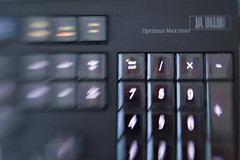
4) The display is insanely bright. So bright that I usually turn it down to -3 or -2 setting, where the range is -3 to +3.
5) The camera shows all necessary information on its displays. That includes showing the ISO setting on the additional display below the main display, making it, even for me, hard to forget fixing the ISO. The two additional LCDs also show which CF slot holds a CF card and which of the two are in use.
6) The camera shows the lightmeter vertically right to the picture in the viewer. This is much better than in the D200 where it is below the picture. It also allows the camera to display more information which I really appreciate.
7) The portrait shutter release can be locked. So it does not matter where you place the right hand for landscape shots.
8) The D200 had a 'last used' settings tab. Now the D3 has a favorites tab which is fully customizable. I use both and like the new version much better as my favorite entries don't get shifted around just because I used them.
9) The D3 usually does not need a flash. And thus it has none integrated. The SB-800 can be mounted and works just great. The only sad thing is that the D3 also has no integrated flash remote control either. This speaks for a SU-800 Wireless Speedlight Commander which is part of the R1 Wireless Close-Up Seedlight System.
10) The Nikkor 105/2.8/VR suddenly got a much nicer range and even serves as a very good portrait lens now.

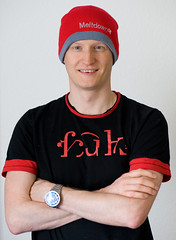
The pro list could be extended a lot. But actually there was not so much to improve when coming from a D200.
Most things feel just as they should be and there is hardly anything wrong with the camera. So I spend a few days shooting, collecting all the things I do not like. Here goes:
1) First of all, Nikon obviously tried to give the D3 a superior strap compared to the D200 or the D300. To me it is just too broad; the old one was much better. So the first thing after buying the Nikkor 24-120/VR was a new strap!

2) I even read the book (aka manual)—but Nikon indeed removed my favorite pre-shutter mirror-flipping mode. Of course, the D3 has a mode where you can flip the mirror with first pushing on the shutter release button and then taking the shot with a second push. But what about the nice mode where you just press once and the camera waits a split of a second? It is an awesome feature, it usually gave me one additional stop.
3) Nikon still refuses to care for its customers. I mean you can now add some crappy signing to the pictures. But hey, I still cannot claim the camera to be mine. That's unbelievable. The EXIF standard has both author and copyright tag (though sadly combined in one tag). And of course the camera does not ask me to point it to my PGP or whatever key. Without that what is the signing good for? I guess it makes people that have no clue feel better. For all the rest, this is useless becasue you can always get rid of this signing, post-process the picture and re-create it. And of course this includes changing the author and copyright info some software adds for you. Photokina is ahead, if I have time for it I will once again ask about this insanity.
4) There is no ISO setting below 100, not even with stupid filtering in the camera. Not that I personally will ever miss it though.
5) The HDMI output is pretty poor. On preview it uses the thumbnails, in other words it has very low resolution and the output simply looks crappy. Hey, I have a 46" screen and I would expect that people buying a D3 and use the HDMI would use nothing smaller. Now it gets a bit better when changing to a slide show. However there is no 1080p mode and the 720p mode looks in my opinion a tad bit better than the 1080i mode. Either way, not worth buying an HDMI cable. This said, it does not really matter that the camera allows neither 1920x1080 nor 3840x2160 resolution.
6) When doing a firmware update, you have to upload the firmware files separately to exactly one CF card. When using both CFs, the camera simply refuses to accept any firmware file and when finding both it always selects the same one. At least the order in which you do the update does not matter. Well so far it does not.
7) Once again the focus points are all around the center of the sensor. They only spread so much that you get about one focus point per golden cut. Meaning one probably uses about 9 focus points. As a tip for Nikon, if the corner focus points are used extremely often, then that is probably based on the fact that people are missing points closer to the edges.
8) The function button still cannot do everything. And of course it cannot do pre-shutter mirror-flipping. Simply becasue the mode is gone (see 2).
9) The camera does not allow to add a 'normal playback' mode as Caitlin called it. Meaning you cannot set the camera to show some information while having at least one screen without any data (over-exposure areas, focus points, etc.).
10) The view finder is really awesome. But the rubber, the eyepiece you put, well, to your eye, is simply bad. So the next things I ordered was a DK-17M and a DK-19.
Now all of the above are really minor complaints. And there is a hell lot of good things to mention. Just to mention a few highlights:
1) The result at ISO 1600 is simply great! Yes, this is why I bought the camera. And it makes me really happy. And just as many other people said before, simply keep the D3 at ISO 1600 at all time, unless you have to use lower ISO because of aperture constrains.
2) The Nikkor 50/1.4D is finally usable.

But it still is a lens that I have to replace. Now, Sigma just announced the new 50mm F1.4 EX DG HSM which could be an alternative as well as the Zeiss Planar T* 1.4/50. But maybe the answer is the Nikkor 85/1.4D or the Zeiss Planar T* 1.4/85.
3) The view finder is just amazing. Bright and large! And even I can do manual focusing now! This makes operating my Lensbaby much easier.

4) The display is insanely bright. So bright that I usually turn it down to -3 or -2 setting, where the range is -3 to +3.
5) The camera shows all necessary information on its displays. That includes showing the ISO setting on the additional display below the main display, making it, even for me, hard to forget fixing the ISO. The two additional LCDs also show which CF slot holds a CF card and which of the two are in use.
6) The camera shows the lightmeter vertically right to the picture in the viewer. This is much better than in the D200 where it is below the picture. It also allows the camera to display more information which I really appreciate.
7) The portrait shutter release can be locked. So it does not matter where you place the right hand for landscape shots.
8) The D200 had a 'last used' settings tab. Now the D3 has a favorites tab which is fully customizable. I use both and like the new version much better as my favorite entries don't get shifted around just because I used them.
9) The D3 usually does not need a flash. And thus it has none integrated. The SB-800 can be mounted and works just great. The only sad thing is that the D3 also has no integrated flash remote control either. This speaks for a SU-800 Wireless Speedlight Commander which is part of the R1 Wireless Close-Up Seedlight System.
10) The Nikkor 105/2.8/VR suddenly got a much nicer range and even serves as a very good portrait lens now.


The pro list could be extended a lot. But actually there was not so much to improve when coming from a D200.
Blogged with the Flock Browser
Labels: Photography
Sunday, May 11, 2008
The D3 arrived. Part I: Now I need a new lens
The camera change from Nikon D200 to Nikon D3 with its sensor size change from APS-C aka DX to full frame aka FX unfortunately made the purchase of a new all rounder lens imminent. And so I switched from 'AF-S DX VR Zoom-NIKKOR 18-200mm f/3.5-5.6G IF-ED' to 'AF-S VR Zoom-NIKKOR 24-120mm f/3.5-5.6G IF-ED'.
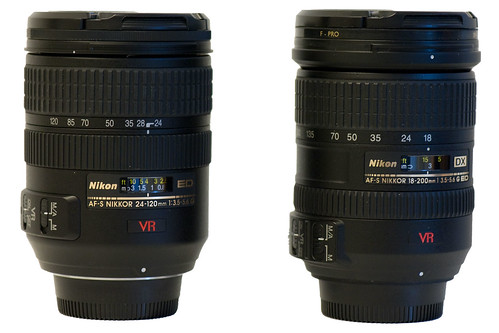
The picture was shot using the 'AF-S VR Micro-NIKKOR 105mm f/2.8G IF-ED' on the D3 and post-processed with Adobe Lightroom 2.0 beta and Corel Paint Shop Pro XI.
Both lenses have a UV filter mounted. The 18-200/VR has a B&W filter while the 24-120/VR has a Hoya filter. Both lenses come with VR and share the same aperture range, that is f/3.5 to f/5.6. Also the wide range is very compareable as the 18mm on the DX camera turns into 27mm on 36mm film, while the 24mm are already correct in terms of 36mm film equivalent, when mounted on the D3.
The unfortunate difference is the telephoto range. Here the 200mm DX format turns into 300mm on 36mm film. And that is way more than the 120mm of the FX lens.
Interestingly, the switch does not come with a handling difference - at least not in lens handling. Both lenses nearly look identical and share a more or less identical housing. But as to be expected, the 18-200 goes out much more than the 24-120 does. Sharpness-wise it appears both lenses deliver the same quality. Meaning they do a great everyday job but do not take very sharp pictures. Since even the flowers of both lenses are nearly identical, I had to check the internet to figure out which one belongs on which lens. The HB-35 has broader fins and belongs on the 18-200. The 24-120 is a tad bit wider, so it takes the HB-25 with its smaller fins.
I actually bought the camera and lens in Switzerland where prices are insanely high - though yet much lower than for instance in Germany. So I spent some time searching for shops with reasonable prices. I found digitec in Zürich and ars-imago in Zug, which was not too far away and unlike digitec, where I bought the camera, had the lens in stock.
I had to go twice to digitec because the first time they figured they could not get enough money from my ATM cards. It turned out that my two German ones only allow higher charges in Germany - or they just don't care so that you pay with Credit Card. For that however they happily charge 2.75% extra. That is absolutely ridiculous and of course unacceptable. So I came back the next day after visiting my bank in the morning. And believe me, it really feels strange running around with 6k in cash.
When I decided for the lens and found ars-imago I chose them for one reason. It was the cheapest place with the lens in stock that was reachable by car. There was one shop where I could have ordered the lens on-line. Including charges for shipping I would have paid the same, well there also is the credit card insanity. So I either would have had to wait longer or pay this unbelievable special Swiss insanity extra charge. So I happily drove to Zug after reading that there was the last lens of its kind waiting for me to be picked up. However when I arrived they told me with the typical Swiss smile, that my lens was sold half an hour ago. That means that those idiots sold my lens just after they sent me the confirmation that I can pick up the lens on the same day. They assured me the lens would come next business day which was two days later. So I lost one day for experimenting - dammit! The least thing one would expect now - of course - is that they would give a bit of a rebate for making me drive twice. But nothing - that's Switzerland. Lesson learned, never buy anything from ars-imago again.

The picture was shot using the 'AF-S VR Micro-NIKKOR 105mm f/2.8G IF-ED' on the D3 and post-processed with Adobe Lightroom 2.0 beta and Corel Paint Shop Pro XI.
Both lenses have a UV filter mounted. The 18-200/VR has a B&W filter while the 24-120/VR has a Hoya filter. Both lenses come with VR and share the same aperture range, that is f/3.5 to f/5.6. Also the wide range is very compareable as the 18mm on the DX camera turns into 27mm on 36mm film, while the 24mm are already correct in terms of 36mm film equivalent, when mounted on the D3.
The unfortunate difference is the telephoto range. Here the 200mm DX format turns into 300mm on 36mm film. And that is way more than the 120mm of the FX lens.
Interestingly, the switch does not come with a handling difference - at least not in lens handling. Both lenses nearly look identical and share a more or less identical housing. But as to be expected, the 18-200 goes out much more than the 24-120 does. Sharpness-wise it appears both lenses deliver the same quality. Meaning they do a great everyday job but do not take very sharp pictures. Since even the flowers of both lenses are nearly identical, I had to check the internet to figure out which one belongs on which lens. The HB-35 has broader fins and belongs on the 18-200. The 24-120 is a tad bit wider, so it takes the HB-25 with its smaller fins.
I actually bought the camera and lens in Switzerland where prices are insanely high - though yet much lower than for instance in Germany. So I spent some time searching for shops with reasonable prices. I found digitec in Zürich and ars-imago in Zug, which was not too far away and unlike digitec, where I bought the camera, had the lens in stock.
I had to go twice to digitec because the first time they figured they could not get enough money from my ATM cards. It turned out that my two German ones only allow higher charges in Germany - or they just don't care so that you pay with Credit Card. For that however they happily charge 2.75% extra. That is absolutely ridiculous and of course unacceptable. So I came back the next day after visiting my bank in the morning. And believe me, it really feels strange running around with 6k in cash.
When I decided for the lens and found ars-imago I chose them for one reason. It was the cheapest place with the lens in stock that was reachable by car. There was one shop where I could have ordered the lens on-line. Including charges for shipping I would have paid the same, well there also is the credit card insanity. So I either would have had to wait longer or pay this unbelievable special Swiss insanity extra charge. So I happily drove to Zug after reading that there was the last lens of its kind waiting for me to be picked up. However when I arrived they told me with the typical Swiss smile, that my lens was sold half an hour ago. That means that those idiots sold my lens just after they sent me the confirmation that I can pick up the lens on the same day. They assured me the lens would come next business day which was two days later. So I lost one day for experimenting - dammit! The least thing one would expect now - of course - is that they would give a bit of a rebate for making me drive twice. But nothing - that's Switzerland. Lesson learned, never buy anything from ars-imago again.
Blogged with the Flock Browser
Labels: Photography
Subscribe to Posts [Atom]
